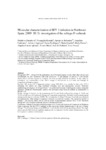Mostrar o rexistro simple do ítem
Molecular characterization of HIV-1 infection in Northwest Spain (2009–2013): investigation of the subtype F outbreak
| dc.contributor.author | Paraskevis, Dimitrios | |
| dc.contributor.author | Kostaki, Evangelia | |
| dc.contributor.author | Beloukas, Apostolos | |
| dc.contributor.author | Cañizares, Angelina | |
| dc.contributor.author | Aguilera, Antonio | |
| dc.contributor.author | Rodríguez, Javier | |
| dc.contributor.author | Grandal, Marta | |
| dc.contributor.author | Pernas, Berta | |
| dc.contributor.author | Castro-Iglesias, Ángeles | |
| dc.contributor.author | Mena, Álvaro | |
| dc.contributor.author | Pedreira, José D. | |
| dc.contributor.author | Poveda, Eva | |
| dc.date.accessioned | 2017-04-07T11:16:31Z | |
| dc.date.available | 2017-04-07T11:16:31Z | |
| dc.date.issued | 2014-12-16 | |
| dc.identifier.citation | Paraskevis D, Kostaki E, Beloukas, et al. Molecular characterization of HIV-1 infection in Northwest Spain (2009–2013): investigation of the subtype F outbreak. Infec Genet Evol. 2015;30:96-101 | es_ES |
| dc.identifier.issn | 1567-1348 | |
| dc.identifier.issn | 1567-7257 | |
| dc.identifier.uri | http://hdl.handle.net/2183/18393 | |
| dc.description.abstract | [Abstract] Background. HIV-1 subtype B is the predominant one in European regions several, while other subtypes and recombinants are also circulating with high prevalence. A sub-epidemic of subtype F with specific characteristics and low response to treatment has been recently identified in Galicia. In this study we investigated the characteristics of the HIV-1 subtype F sub-epidemic in A Coruña and Santiago de Compostela in Northwest Spain. Methods. 420 newly HIV-1 diagnosed patients during 2009–2013 were enrolled in this study. HIV-1 subtyping was carried out using automated subtyping tools and phylogenetic analysis. Molecular epidemiology investigation of subtypes B and F was performed by means of phylogenetic analysis using fast maximum likelihood. Phylodynamic analysis was performed using Bayesian method as implemented in BEAST v1.8. Results. Subtype B found to be the predominant (61.2% and 70.4%) followed by subtype F (25.6% and 12.0%) in both areas (A Coruña and Santiago de Compostela, respectively). The latter found to mainly spread among men having sex with men (MSM). The vast majority of subtype F lineages from both areas clustered monophyletically, while subtype B sequences clustered in several tree branches. The exponential growth of subtype F sub-epidemic dated back in 2008 by means of phylodynamic analysis. Most of new infections during 2009–2013 occurred within the subtype F transmission cluster. Conclusions. Subtype F circulates at high prevalence in A Coruña and Santiago de Compostela in Northwest Spain, suggesting that the HIV-1 epidemic in this region has distinct characteristics to the rest of Spain. Subtype F has being spreading among MSM and is currently the most actively spreading network. The single cluster spread of this local sub-epidemic might provide an explanation for the distinct characteristics and the low response to antiretroviral treatment. | es_ES |
| dc.language.iso | eng | es_ES |
| dc.publisher | Elsevier | es_ES |
| dc.relation.uri | http://doi.org/10.1016/j.meegid.2014.12.012 | es_ES |
| dc.rights | Atribución-NoComercial-SinDerivadas 3.0 España | es_ES |
| dc.rights.uri | http://creativecommons.org/licenses/by-nc-nd/3.0/es/ | * |
| dc.subject | HIV-1 | es_ES |
| dc.subject | Subtype F | es_ES |
| dc.subject | Galicia | es_ES |
| dc.subject | Spain | es_ES |
| dc.subject | Local sub-epidemic | es_ES |
| dc.subject | Molecular epidemiology | es_ES |
| dc.title | Molecular characterization of HIV-1 infection in Northwest Spain (2009–2013): investigation of the subtype F outbreak | es_ES |
| dc.type | info:eu-repo/semantics/article | es_ES |
| dc.rights.access | info:eu-repo/semantics/openAccess | es_ES |
| UDC.journalTitle | Infection, Genetics and Evolution | es_ES |
| UDC.volume | 30 | es_ES |
| UDC.startPage | 96 | es_ES |
| UDC.endPage | 101 | es_ES |
Ficheiros no ítem
Este ítem aparece na(s) seguinte(s) colección(s)
-
INIBIC-VC - Artigos [37]






